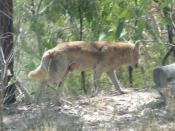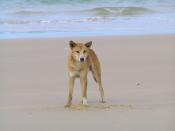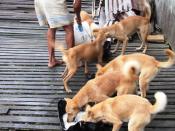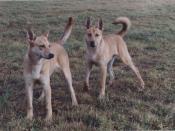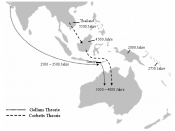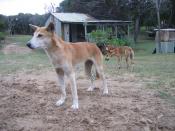Nobody is exactly sure where the dingo ÃÂCanis familiaris dingoÃÂ came from, it isnÃÂt originally from Austrailia but arrived between 3,500 to 4,000 years ago. The oldest dingo fossil is dated at about 3,400 years old. It is thought that the dingo is from the same family as the Indian Wolf, like many domestic dogs (Canis familiaris), but it has enough of its ancestors charachteristics that it has its own variety.
There are two theories about where the dingo came from. One is that its relatives lived in India and were brought there by indian traders. The other is that its relatives were from south east Asia and was brought there by people traveling the sea. However it happened dingoes did very well in Australia. Their only competition was the Tasmanian devil, the thylacine, and the tiger cat. That competition is pobably what made these animals move to Tasmania which the dingo never reached.
Dingoes donÃÂt form packs like other wild dogs, they either live alone or in small families. Dingoes mate for life and mate once a year. The families have home territories that they rarely leave. Dingo families may co-operate to catch large animals. Dingoes chase their prey. They wear them out in a long chase because they arenÃÂt very fast runners. Large animals are chased until the dingoes can catch them or until the weaker ones drop back. Dingoes donÃÂt always get their prey, however kangaroos can lean back on their tails and kick hard enough to rip open a dingoÃÂs stomach.
The gestation period of the dingo is about 63 days, and the litters average about 5 to 8 pups. After 2 weeks, the mother will throw up food for the pups to eat. After 3 weeks, both parents will bring food to the den. Prey around the den is left for the pups to practice hunting.
The usual color of dingoes is yellow-ginger. However other colors have appeared. In northern and central Austrailia, 88.6% of the dingoes are yellow-ginger, 3.8% are black and tan, and 1.9% are white. In southern Austrailia, yellow-ginger dingoes have decreased by 45.9%, but black and tan have increased dy 19.1%, and white dingoes have almost dissapeared.
Since Europeans came to Austrailia to farm, dingoes have been nothing but a problem for them. Dingoes kill thousands of sheep and cattle each year. A familiy of dingoes can kill over twenty a night for no reason but blood lust or the young dingoes getting excited. Thousands of miles of fence have been put up in defence.
The Aboiginnes and early white settlers took puppies from the nest at a very youing age because once the puppies start to compete with each other, they wonÃÂt accept humans. Dingoes must be captured at a very young age to get a good bond with their owners. If they are taken at six weeks they will only tame a little. If they are taken at ten weeks, they will never make pets and shouldnÃÂt be taken from the wild. Dingoes rarely show aggression. They run rather than fight. Dingoes are very agile but usually just lay around. Water is a barrier to dingoes because they donÃÂt swim, only wade.
Dingo ÃÂCanus familiaris dingoàAnimailia Cordata Mamalia Carnivora Canidae Canis familiaris dingo Bibilyography 1.ÃÂDingoÃÂ. International Wildlife Encyclopedia. Vol. 7 Page 771 é1990.
2.http://www.wwwins.net.au/dog/downunder.html 3.http://www.wwwins.net.au/oldtimers/oldtimers.html
